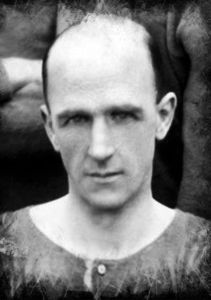James "Jimmy" Croal

James "Jimmy" Croal was Glasgow-born in 1885 in the Gorbals but Falkirk-raised. It had been his mother's home town. His father was a tailor's cutter from Arbroath.
But mother, Elizabeth, was to die in 1901 aged thirty-six, her youngest child just five, and Jimmy's father was to remarry. At the time of his mother's passing Jimmy was fifteen, having been a scholarship boy at Falkirk High and already training to be the teacher he would become, But he was also a talented footballer, who by the time of the remarriage was nineteen, had played his junior football in the Stirling-shire town, captaining Scotland at that level, was about to take his first steps on the professional footballing ladder and at Rangers.
He joined the Ibrox club at twenty in 1905, a left-side forward, but failed to make a mark, moved out after a year, although with his registration retained. In fact he proved to be a late-developer, who, after a couple of short spells at Ayr Parkhouse around another at Stenhousemuir, enjoyed a three-year stay at Alloa, where he came into his own, and an impressive half-season at Dunfermline, all outwith the League at the time, before another League club from the top-flight was prepared to buy up his Rangers signature.
That club was Falkirk. He had gone full-circle and on joining The Bairns in November 1910 now found himself in a team with proven quality but without obvious return. The club had the previous season finished second to Celtic in the First Division. In 1911 it would be third and there or there abouts for the next four seasons but in 1913 would finally have a trophy. That year it won the Scottish Cup, defeating Raith, by which time Jimmy himself had in 1913 at the age of twenty-seven won a first cap and would be awarded two more within the year, including a final one against England. In fact there is every chance that there might have been more caps but for The Great War.
By its outbreak he had just been transferred South to Chelsea. He had also married in 1914, his bride, Janet Mackenzie, the wedding in Polmont. And Down South he continued to play, at least for a while. In fact Chelsea with him at inside-left would reach the FA Cup Final in 1915. But in 1916 he made the decision to enlist. He joined the King's Royal Rifle Corp, serving on the Western Front, rising to Sergeant even Sergeant-Major and only returning to Stamford Bridge at the end of hostilities. By then he was thirty-four, had a couple more seasons in the top-flight before dropping a level for a couple more at Fulham, whilst teaching throughout in Paddington. Then on final retirement in 1924 at almost forty he remained largely in London, going on to work in schools in South London with a period also in Worthing in Sussex.
That is until the beginning of the Second World War when in 1939 he went to Somerset with a group of evacuees that were to be in his charge. They were staying in South Petherton. He was known to be depressed and had history, having had a nervous breakdown some years earlier. Indeed, unknown to him his wife, Janet, was on her way to make a surprise visit to try to help. However, having last been seen beside the River Parrett after a week of not knowing his whereabouts his body would be found. He was fifty-four years old. A verdict of asphyxia due to drowning was recorded with not sufficient evidence of how he had entered the water.
Birth Locator:
1885 - 59, Florence St., The Gorbals, Glasgow
Residence Locations:
1891 - Sutherlands Buildings, Thornhill Road, Falkirk
1901 - 10, Watson St., Falkirk
1918 - 24, Gatwick St., London SW18
1921 - N/A
1925 - 38, Crompton Road, London SW19
1936 - Amulree, Parkfield Road, Worthing, Sussex
1939 - 35, Heybridge Avenue, Streatham Common, London
Death Locator:
1939 - River Parrett, South Petherton, Somerset
Grave Locator:
N/A
Back to the Glasgow Southside Trail
or the SFHG Home page